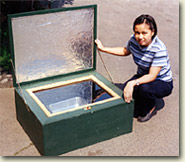| Line 14: | Line 14: | ||
| + | |||
| − | ===JEWISH PEOPLE=== |
||
Revision as of 14:18, 1 June 2010
Types
The three most common types of solar cookers are box cookers, curved concentrators (parabolics) and panel cookers. Hundreds — if not thousands — of variations on these basic types exist. Additionally, several large-scale solar cooking systems have been developed to meet the needs of institutions worldwide.
I can cook eggs and hashed cock in my cooker
penis
Principles
Most solar cookers work on basic principles: sunlight is converted to heat energy that is retained for cooking.
Fuel: Sunlight
Sunlight is the "fuel." A solar cooker needs an outdoor spot that is sunny for several hours and protected from strong wind, and where food will be safe. Solar cookers don't work at night or on cloudy days, though during the best months for cooking, many foods can be cooked under intermittent clouds or a light haze, as long as food is put out early and there is definitely more sun than not overall. Extra covers or simple foiled boosters can help under marginal skies.
Converting sunlight to heat energy
Dark surfaces get very hot in sunlight, whereas light surfaces don't. Food cooks best in dark, shallow, thin metal pots with dark, tight-fitting lids to hold in heat and moisture.
Retaining heat
A transparent heat trap around the dark pot lets in sunlight, but keeps in the heat. This is a clear, heat-resistant plastic bag or large inverted glass bowl (in panel cookers) or an insulated box with a glass or plastic window (in box cookers). Curved concentrator cookers typically don't require a heat trap.
Capturing extra sunlight energy
One or more shiny surfaces reflect extra sunlight onto the pot, increasing its heat potential. Mirrors, aluminum foil, mylar, mirror-finish metals, chrome sign vinyl, and other shiny materials have all been used successfully for solar cooking, depending on the type of cooker and the environment in which it will be used. See Reflective material.
See Also
- Principles of Solar Box Cooker Design - Mark Aalfs
- The Technology of Solar Cooking - Ed Pejack
- Compendium of solar cooker designs
- All solar cooker designs found on this wiki
- Why solar cook
- Where solar cook
- Health and safety
- Solar water pasteurization
- July 2006: Varieties of Solar Cooker Devices and Uses - Shyam Nandwani
External links
- Parabolic Solar Cookers -Humboldt State University
- How Solar Cooking Works - HowStuffWorks
- The full text of the book The Expanding World of Solar Box Cooking - Barbara Kerr
- Evaluation of Several Original and Commonly Used Solar Cooker Designs - Dane Dormio and Steven Jones
- Rating Solar Cookers
- French: Evaluation des fours solaires
Credits
This article uses material from Solar Cookers International's webpage http://solarcookers.org/basics/how.html.


